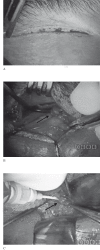Endovascular occlusion of dural cavernous fistulas through a superior ophthalmic vein approach
- PMID: 24199817
- PMCID: PMC4202836
- DOI: 10.1177/197140091302600510
Endovascular occlusion of dural cavernous fistulas through a superior ophthalmic vein approach
Abstract
Dural cavernous fistulas are low-flow vascular malformations with usually benign clinical course and a high rate of spontaneous resolution. Cases with symptom progression must be treated with an endovascular approach by arterial or venous route. We report 30 patients with dural cavernous fistulas treated by coil embolization using surgical exposure and retrograde catheterization of the superior ophthalmic vein (SOV). The procedure resulted in closure of the fistula without other endovascular treatments in all 30 patients and clinical remission or improvement in 20 and eight patients, respectively. Embolization via a SOV approach is a safe and easy endovascular procedure, particularly indicated for dural cavernous fistulas with exclusive or prevalent internal carotid artery feeders and anterior venous drainage.
Keywords: cavernous sinus; dural cavernous fistula; embolization; superior ophthalmic vein.
Figures




Similar articles
-
Embolization of Dural Arteriovenous Fistula of the Cavernous Sinus Through Percutaneous Ultrasound-Guided Puncture of the Facial Vein.World Neurosurg. 2017 Mar;99:812.e13-812.e20. doi: 10.1016/j.wneu.2016.12.048. Epub 2016 Dec 23. World Neurosurg. 2017. PMID: 28017743
-
Cavernous sinus dural fistulae treated by transvenous approach through the facial vein: report of seven cases and review of the literature.AJNR Am J Neuroradiol. 2003 Jun-Jul;24(6):1240-6. AJNR Am J Neuroradiol. 2003. PMID: 12812963 Free PMC article.
-
Superficial middle temporal vein as a pivotal route to embolize dural carotid-cavernous fistulas.J Clin Neurosci. 2021 Feb;84:106-110. doi: 10.1016/j.jocn.2020.11.019. Epub 2020 Dec 24. J Clin Neurosci. 2021. PMID: 33358092
-
[Endovascular management of cavernous sinus dural fistulas].Bol Asoc Med P R. 2014;106(1):17-24. Bol Asoc Med P R. 2014. PMID: 24791359 Review. Spanish.
-
Surgical Sparing and Pairing Endovascular Interventions for Carotid-Cavernous Fistula: Case Series and Review of the Literature.World Neurosurg. 2020 Aug;140:18-25. doi: 10.1016/j.wneu.2020.05.013. Epub 2020 May 11. World Neurosurg. 2020. PMID: 32437988 Review.
Cited by
-
Transorbital hybrid approach for endovascular occlusion of indirect carotid-cavernous fistulas-Case report and systematic literature review.Radiol Case Rep. 2022 Jul 12;17(9):3312-3317. doi: 10.1016/j.radcr.2022.06.043. eCollection 2022 Sep. Radiol Case Rep. 2022. PMID: 35846510 Free PMC article.
-
Cavernous sinus dural arteriovenous fistula accessed through a straightened superficial temporal vein.Surg Neurol Int. 2021 Dec 30;12:634. doi: 10.25259/SNI_1035_2021. eCollection 2021. Surg Neurol Int. 2021. PMID: 35350822 Free PMC article.
-
The routes for embolization of dural carotid cavernous fistulas when the endovascular approach is indicated as a first-line strategy.Interv Neuroradiol. 2019 Feb;25(1):66-70. doi: 10.1177/1591019918796493. Epub 2018 Aug 30. Interv Neuroradiol. 2019. PMID: 30165774 Free PMC article.
-
Clinical efficacy of endovascular treatment approach in patients with carotid cavernous fistula: A systematic review and meta-analysis.World Neurosurg X. 2023 Mar 29;19:100189. doi: 10.1016/j.wnsx.2023.100189. eCollection 2023 Jul. World Neurosurg X. 2023. PMID: 37223772 Free PMC article. Review.
References
-
- Debrun GM, Viñuela F, Fox AJ, et al. Indications for treatment and classification of 132 carotid-cavernous fistulas. Neurosurgery. 1988;22:285–289. - PubMed
-
- Cognard C, Gobin YP, Pierrot L, et al. Cerebral dural arteriovenous fistulas: clinical and angiographic correlation with a revised classification of venous drainage. Radiology. 1995;194:671–680. - PubMed
-
- Djindjian R, Merland JJ, Theron J. Superselective arteriography of the external carotid artery. New York: Springer-Verlag; 1997.
-
- Borden JA, Wu KE, Shicart WA. A proposed classification for spinal and cranial dural arteriovenous fistulous malformations and implications for treatment. J Neurosurg. 1995;82:166–179. - PubMed
-
- Phelps CD, Thompson HS, Ossoinig KC. The diagnosis and prognosis of atypical carotid-cavernous fistula (red-eyed shunt syndrome) Am J Ophthalmol. 1982;93:423–436. - PubMed
MeSH terms
LinkOut - more resources
Full Text Sources
Other Literature Sources

